Trendspotting at Photoville
Take a bare strip of land on the Brooklyn waterfront, throw in some shipping containers, add lashings of photography and a generous pinch of the Brooklyn hipster vibe, and what do you get? The answer is Photoville , the spunky pop-up photo festival that is going on now, celebrating its second year.
Last year, the inaugural Photoville (which I wrote about here ) came as a pleasant surprise. The most relaxed and accessible of the city’s photo festivals, it was a breath of fresh air in the sometimes stuffy atmosphere of the art-photography world. It featured an eclectic range of photographers, ranging from big names to students and non-professionals. And because each group or individual was assigned a more or less identical shipping container in which to exhibit, there was no sense of anyone lording it over anyone else.
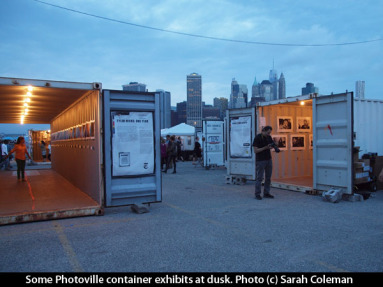 This year, Photoville has built on last year’s success, becoming slightly bigger but retaining its open-to-everything vibe. There’s a great lineup of
workshops and talks
,
nighttime screenings and events
, and arguably, some of the most envelope-pushing work going on in photography today. I look forward to attending some events there next weekend; in the meantime, here are a few observations on trends I noticed during my first visit.
This year, Photoville has built on last year’s success, becoming slightly bigger but retaining its open-to-everything vibe. There’s a great lineup of
workshops and talks
,
nighttime screenings and events
, and arguably, some of the most envelope-pushing work going on in photography today. I look forward to attending some events there next weekend; in the meantime, here are a few observations on trends I noticed during my first visit.
1. New ways of exhibiting photographs
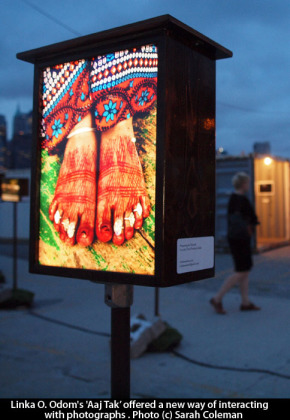 One of the most striking exhibits at this year’s show was Linka O. Odom’s
‘Aaj Tak,’
a series of photos of India displayed in wooden lightboxes on top of poles. This was especially effective at night, when the lightboxes lit up like mini stained glass windows, and the intense colors of India shone through. Though Odom’s photography offered a fairly standard view of India, the mode of exhibition allowed people to interact with it in new and interesting ways.
One of the most striking exhibits at this year’s show was Linka O. Odom’s
‘Aaj Tak,’
a series of photos of India displayed in wooden lightboxes on top of poles. This was especially effective at night, when the lightboxes lit up like mini stained glass windows, and the intense colors of India shone through. Though Odom’s photography offered a fairly standard view of India, the mode of exhibition allowed people to interact with it in new and interesting ways.
Other photographers used material elements imaginatively to emphasize the themes of their shows. In Kisha Bari’s ‘How Sandy Hit Rockaway, ‘ sand was strewn around the shipping container as a reminder of the physical devastation wrought by the superstorm. Meanwhile, Donald Weber’s exhibit, ‘Interrogations,’ recreated the claustrophobia of a Russian interrogation room, complete with bad wallpaper, an ashtray full of cigarette butts, and scribblings of interrogators’ thoughts on the walls. (“He never again broke the law. These methods work.”) In both these shows, the power of the subject matter was heightened by physical elements.
2. Partnerships between photographers and community organizations
When media space for serious, hard-hitting documentary photography began disappearing in the 1990s, more and more documentary photographers started partnering with nonprofits as a way to continue their work. In general this has been a client-employee dynamic, with photographers paid by nonprofits to visualize the organization’s work. At Photoville, I noticed another trend: photographers working voluntarily with community organizations and activist groups.
One of the most affecting of these collaborations was the project ‘Photo Requests from Solitary,’ in which photographers produced images based on requests from prisoners in solitary confinement. Some image requests were nostalgic (a favorite aunt’s house), others were pure fantasy (“myself with lions”), but all were revelatory. In the United States, prisoners can be put in solitary confinement for something as little as possessing too many postage stamps; there are over 81,000 such prisoners in the U.S., many of whom commit suicide or become mentally unstable. A panel discussion about the show included two eloquent survivors of solitary confinement, who spoke movingly about their ordeals.
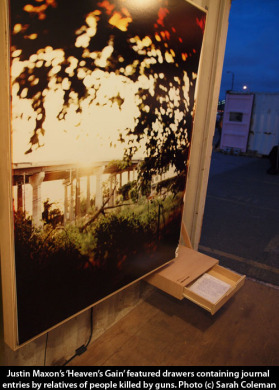 Another project,
Justin Maxon
‘s ‘Heaven’s Gain,’ focused on Chester, a Pennsylvania community where gun violence has wrecked many lives. Along with his photographs and photomontages, Maxon’s container featured journals and taped testimonies of people who’d lost a relative to gun violence. In a panel discussion that included an academic researcher and a community organizer, Maxon said he’d worked closely with the community and its organizers, and had tried to think outside the box to allow others to contribute to the project and share ownership of it. This thoughtfulness was reflected in the design and content of his container, which I thought was one of the standouts in the festival.
Another project,
Justin Maxon
‘s ‘Heaven’s Gain,’ focused on Chester, a Pennsylvania community where gun violence has wrecked many lives. Along with his photographs and photomontages, Maxon’s container featured journals and taped testimonies of people who’d lost a relative to gun violence. In a panel discussion that included an academic researcher and a community organizer, Maxon said he’d worked closely with the community and its organizers, and had tried to think outside the box to allow others to contribute to the project and share ownership of it. This thoughtfulness was reflected in the design and content of his container, which I thought was one of the standouts in the festival.
3. Text/image/audio combinations
Obviously, this is an area close to The Literate Lens’s heart and something I’m always sensitive to, but I noticed many photographers using text in interesting ways to supplement their images—two examples being Donald Weber’s ‘Interrogations’ and Justin Maxon’s ‘Heaven’s Gain,’ mentioned above.
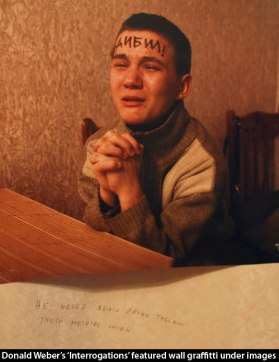 Another was ‘Lost and Found,’ an innovative collaboration between Magnum’s
Susan Meiselas
and playwrights Ruben Carbajal and Michael Shaw Fisher. The playwrights took an iconic Lewis Hine image of Italian immigrants at Ellis Island, and a contemporary Meiselas image of Latino immigrants, and wrote short plays inspired by them. The audio was played in a loop with the images, and though Photoville may not have been the best setting for this (I noticed most people going in and out quickly, not sticking around for the whole plays) it was an interesting and different use of multimedia.
Another was ‘Lost and Found,’ an innovative collaboration between Magnum’s
Susan Meiselas
and playwrights Ruben Carbajal and Michael Shaw Fisher. The playwrights took an iconic Lewis Hine image of Italian immigrants at Ellis Island, and a contemporary Meiselas image of Latino immigrants, and wrote short plays inspired by them. The audio was played in a loop with the images, and though Photoville may not have been the best setting for this (I noticed most people going in and out quickly, not sticking around for the whole plays) it was an interesting and different use of multimedia.
Unlike the Meiselas work, Nina Berman’s ‘Fractured: The Shale Play’ was not actually a play, but rather a stunning visualization of the effects of hydraulic fracturing (“fracking”) on a community in Pennsylvania. Berman’s project ‘Purple Hearts’ was one of the most moving works of documentary to come out of the Iraq War, and her attempt to visualize fracking is equally powerful, featuring multimedia (video and audio recordings of people in the affected communities) as well as images of sickened animals and faucets disgorging water so gassy that it can be ignited.
Of course, some of this isn’t new. Contextualization is often needed for photography, and has historically been provided in the form of written text. Back in the Progressive Era of the early twentieth century, activist photographers gave lantern slide lectures or supplemented their powerful images with punchy text that would grab viewers’ attention. (See the image by Lewis Hine at right.)
 But we’ve entered a new era, where the “straight” photograph is more in doubt than ever, and there’s so much visual noise around us that adding other, innovative elements can help make images stand out. According to writer and NYU professor Fred Ritchin, a Photoville speaker, “When you have a revolution, you have to do revolutionary things.”
But we’ve entered a new era, where the “straight” photograph is more in doubt than ever, and there’s so much visual noise around us that adding other, innovative elements can help make images stand out. According to writer and NYU professor Fred Ritchin, a Photoville speaker, “When you have a revolution, you have to do revolutionary things.”
Ritchin (a former picture editor of the New York Times Magazine ), is a supple, out-of-the-box-thinker, and in his talk on Sunday, he questioned why photographers weren’t “being more subversive” and imagined various tweaks that would change the way digital photography is consumed. One of his proposals, a standardized set of icons, would show viewers when and how an image had been manipulated. Another, roll-over pop-ups in each corner of a news image, would put the image in context for viewers. “We have so many photographs: what we need is people who can look at images and say what they mean,” he said, referring to this as “meta-photography.”
 One of the most interesting ideas Ritchin floated (and which is in his new book,
‘Bending the Frame’
) was that photography should move from being reactive to proactive. In other words, instead of photographing in the wake of crisis, photographers should anticipate crisis and visualize it in order to prevent it from happening. He called this ‘Photography of the Future.’ (Click
here
for an interesting article by Ritchin, mentioning many innovative photography projects that are “bending the frame.”)
One of the most interesting ideas Ritchin floated (and which is in his new book,
‘Bending the Frame’
) was that photography should move from being reactive to proactive. In other words, instead of photographing in the wake of crisis, photographers should anticipate crisis and visualize it in order to prevent it from happening. He called this ‘Photography of the Future.’ (Click
here
for an interesting article by Ritchin, mentioning many innovative photography projects that are “bending the frame.”)
I don’t know if Ritchin’s vision will come to pass. But on the evidence of what I saw at Photoville, there are at least plenty of photographers who are trying new things, pushing the envelope. Some of this experimentation may be more successful, some less, but all of it is helping photography stay vibrant and relevant in our turbulent times.
———————————————————————————————————–
Two notes:
First, a very warm welcome to all the new subscribers who’ve jumped on board in the last two weeks as a result of my post ‘Magnum and the Dying Art of Darkroom Printing’ being written up on Gizmodo and PetaPixel . As the response to that post shows, darkroom printers are a passionate lot who will ensure the art survives long into the future! I’m very glad to have you here. Please continue to comment, reblog and spread the word, so that we can make this an active and useful community.
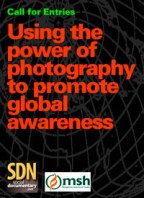 Second, the good folks at
Socialdocumentary.net
have asked me to spread the word about their upcoming contest. This is a great opportunity for all you documentary photographers out there. Socialdocumentary.net is partnering with
Management Sciences for Health (MSH)
to provide two $4,000 fellowships. The winners will spend two weeks documenting a global MSH project, and there will be an additional monetary award and exhibition opportunities for selected entries. If you don’t know
Socialdocumentary.net
, I urge you to check out the site because they do great work to promote documentary photography. The deadline for this contest is midnight EST next Saturday, September 28th, so don’t delay! Dust off those documentary photographs and send them in! More contest details
here
.
Second, the good folks at
Socialdocumentary.net
have asked me to spread the word about their upcoming contest. This is a great opportunity for all you documentary photographers out there. Socialdocumentary.net is partnering with
Management Sciences for Health (MSH)
to provide two $4,000 fellowships. The winners will spend two weeks documenting a global MSH project, and there will be an additional monetary award and exhibition opportunities for selected entries. If you don’t know
Socialdocumentary.net
, I urge you to check out the site because they do great work to promote documentary photography. The deadline for this contest is midnight EST next Saturday, September 28th, so don’t delay! Dust off those documentary photographs and send them in! More contest details
here
.
Information
This entry was posted on September 24, 2013 by sarahjcoleman in Exhibitions and tagged Bending the Frame , Brooklyn , Donald Weber , Fractured: The Shale Play , Fred Ritchin , Heaven's Gain , How Sandy Hit Rockaway , Interrogations , Justin Maxon , Kisha Bari , Lewis Hine , Nina Berman , Photo Requests from Solitary , Photoville , Susan Meiselas .Shortlink
https://wp.me/p25Qfq-w5Recent Posts
Archives
Categories
Enter your email address to follow this blog and receive notifications of new posts by email.
Join 11,055 other followers

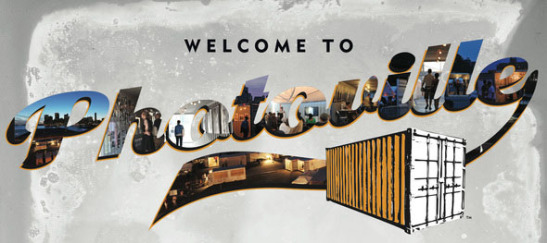
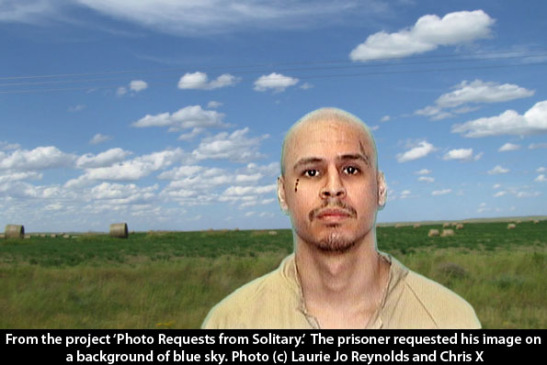
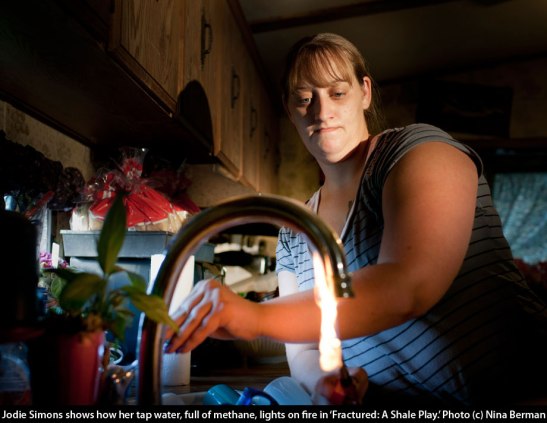

Glad to found have found you!
Thank you, Vassilis: I’m glad to have been found by you! Lots of interesting content coming up this fall (there’s so much happening) so I hope you’ll stay tuned!
Meh……
Hasi, that is very eloquent, but would you care to elaborate? Would love to know what you take issue with!